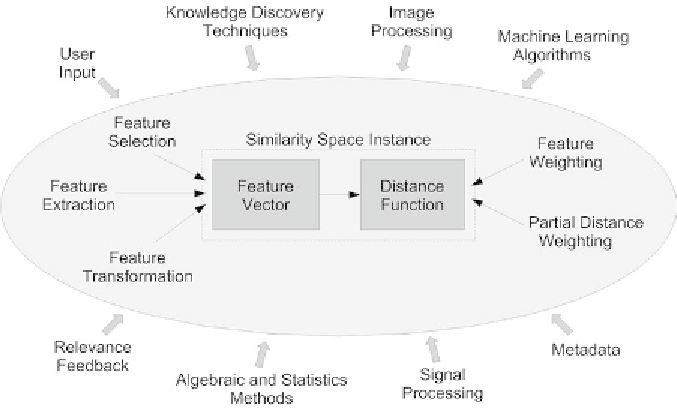Database Reference
In-Depth Information
Figure 1. The basis of a similarity space instance - a feature vector and a distance function - and the
fields and techniques employed to drive its semantics
A Look on the Feature Vector Component
Features describing multimedia data can be classified in three abstraction levels, according to the kinds
of queries that could be answered (Eakins and Graham, 1999).
•
Level 1.
Comprises retrieval by primitive features directly obtained from the multimedia object,
without referring to external knowledge. Examples of such features for still images are general
patterns regarding color, texture, shape or location of elements in the scene. Features describing
videos include these elements plus motion patterns.
•
Level 2.
Comprises retrieval by derived attributes, identified through some degree of logical infer-
ence about the data content. Features capable of identify elements (e.g. a person or an object) and/
or simple movements (e.g. an airplane taking off) are included in this level.
•
Level 3.
Comprises retrieval by abstract features, involving a significant amount of high-level
reasoning. Features in this level can represent more elaborated actions, such as dancing pictures
or videos of children playing with pets.
The abstraction levels present increasing complexity and a tendency to narrow the domain. The lack
of coincidence between the low-level features automatically extracted from the multimedia data (Level
1) and the high-level human interpretation (based on features of levels 2 and 3) is known in the litera-
ture as the
semantic gap
(Smeulders et al., 2000). Many research efforts have been directed to extract
higher-semantic features in order to bridge the gap.
Feature extraction is the first step on which the multimedia data is processed generating a feature
vector. The algorithms that identify the features that aim at inferring the data content are called feature
extractors. There are many feature extractors for multimedia data proposed in the literature. Images are
usually represented through their color, texture and shape patterns extracted either globally in the im-

